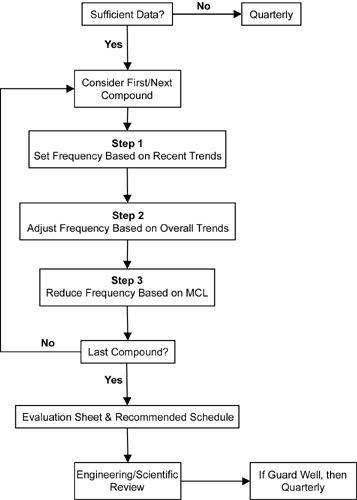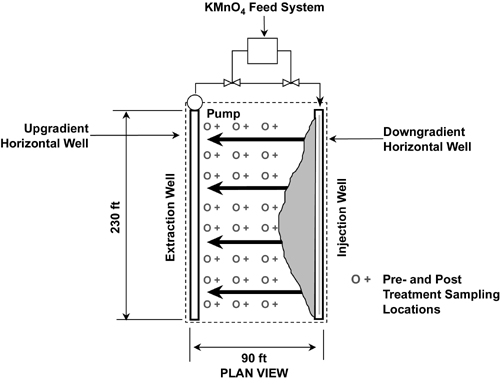Ground Water Currents, June 1999, Issue No. 32ContentsCost-Effective Sampling of Ground Water Monitoring Wells In Situ Chemical Oxidation through Recirculation New Dry-Cleaner Site Remediation Group Convened DNAPL Flushing with Alcoholby Michael Annable, Ph.D., University of Florida, and Randall Sillan, Ph.D., LFR Levine-Fricke University of Florida researchers are evaluating new in situ co-solvent flushing methods to remediate ground water contaminated with dense non-aqueous phase liquids (DNAPL) commonly resulting from dry cleaning activities. At an abandoned site known as Sage’s Dry Cleaners in Jacksonville, FL, a pilot-scale demonstration involving the injection of water and alcohol was conducted in 1998 to remove perchloroethylene (PCE) from ground water. More than 60% of the PCE existing in the subsurface was extracted. Researchers estimate that a pump and treat system would need to operate for 10 years to extract an equivalent volume of PCE. This project was conducted through the State of Florida’s Dry Cleaning Program and Center for Solid and Hazardous Waste Management, with assistance from the U.S. EPA. The source area appeared to be oblong-shaped, approximately 7.3 meters by 2.7 meters. PCE had been released into the subsurface through a sump, and extended 7.9-9.8 meters below ground surface. Tests indicated a NAPL saturation range of 8-35%, and PCE concentrations in soil as high as 45,000 mg/Kg. Based on the results of ground water flow modeling, a total of three injection wells and six recovery wells were installed in a pattern designed to contain the injected fluids hydraulically and provide adequate coverage of the source area. Various tracer tests indicated that approximately 69 liters of PCE existed within the aquifer. The co-solvent solution was delivered to specified depths using packers. Approximately 34,000 liters of a 95% ethanol solution was delivered to the subsurface. (Large quantities of flushing agents were required due to the uneven spatial distribution of the contaminants.) The combined flow rate of water and co-solvent initially was held constant at 4.2 liters per minute for two of the injection wells and at 6.8 liters per minute for the third injection well. Flow rates were adjusted after two days to improve co-solvent contact with the NAPL. To focus more of the co-solvent in the lower portion of the DNAPL-affected area, packers were used in the injection wells to separate a lower co-solvent zone from an upper water flood zone. During the experiment, the packers were raised to increase the size of the co-solvent flood. After 3.5 days, the co-solvent flood zone was reduced by lowering the packers and displacing the co-solvent from the formation with water. Following eight days of flooding, 92% of the injected co-solvent was recovered. In order to minimize cost associated with the disposal of waste containing high levels of PCE, a macro-porous polymer extraction (MPPE) system was used to separate PCE from the extracted co-solvent solution. During treatment, the waste stream was passed through a column containing MPPE material into which the PCE preferentially partitioned. After loading with PCE, the columns were regenerated with low-pressure steam stripping, and the vaporized steam was condensed into free-phase PCE for disposal. Approx-imately 42 of the estimated 69 liters of PCE were separated from the waste stream. The estimated cost of this demonstration was $440,000, including research, design, construction, and operation. Researchers predict that re-use of ethanol could reduce the initial amount of ethanol needed in full-scale implementation of this technology by as much as 50%. It is estimated that full-scale use of this technique at the Sage’s Dry Cleaning site could be completed in one month at a cost of $110,000. In contrast, pump and treat methods could require up to 40 years and $2.2 million. Based on the success of this project, the Florida Dry Cleaning Program is considering this technology for other PCE-contaminated sites. For more information, contact Dr. Michael Annable (University of Florida) at 352-392-3294 or E-mail manna@eng.ufl.edu. Cost-Effective Sampling of Ground Water Monitoring Wellsby Maureen Ridley and Don MacQueen, Lawrence Livermore National Laboratory Lawrence Livermore National Laboratory (LLNL) has begun implementing a new methodology for estimating the lowest-frequency ground water sampling schedule that will provide sufficient information for regulatory and remedial decision-making. Known as Cost-Effective Sampling (CES), this approach has resulted in a 40 percent reduction in the annual number of routine ground water samples taken at LLNL’s Main Site and Site 300 in Livermore, CA. This reduction has saved LLNL $390,000 annually in sampling, data management, and analysis costs. The original method for determining sampling frequencies at LLNL was based on the proximity of a well to a contaminant plume. This approach caused the majority of the wells to be sampled quarterly, including those that had shown no change over an eight-year period, and did not account for the slow rate of contaminant migration occurring. In contrast, the CES approach bases a frequency sampling on concentration changes observed at a given well. CES recommends that sampling frequencies be based on quantitative analysis of the trends, variability, and magnitude of contaminant statistics, which then are interpreted through decision trees. The underlying principle of CES is that sampling should be determined primarily by the rate of change in concentrations at a given location. Accordingly, a higher rate of concentration change (whether upward or downward) indicates the need for frequent sampling, while minimal change suggests a more relaxed sampling schedule. A second rationale for more frequent sampling is the degree of uncertainty displayed in the measured concentrations. Low overall rates of change can be offset by a higher degree of variability, requiring that a more frequent schedule be maintained to define the likely degree of contamination. Conversely, a high rate of change that is highly predictable warrants a lower sampling frequency. Lastly, the magnitude of the measured concentrations affects the interpretation that is placed on rates of change. For example, a yearly change of 50 parts per billion is interpreted differently when the median concentration is 10 versus 1,000. The significance of the absolute concentrations also varies by compound. To be eligible for CES application, a sampling location must have been sampled previously on at least six occasions (or through approximately 18 months of quarterly sampling), have good site characterization/understanding, and clean downgradient wells (guard wells). CES implementation requires that newly installed wells be sampled frequently to build a history for analytical purposes. For each sampling location, decision trees must be used independently for each contaminant in the target list, and the sampling schedule should be equivalent to the most frequent schedule estimated for any individual contaminant. The overall flow of CES is shown in Figure 1.
Use of CES at more than 700 LLNL ground water monitoring wells has resulted in a reduction of quarterly sampling frequency from 418 to 216 events. For more information, contact Maureen Ridley (LLNL) at 925-422-3593 or E-mail ridley1@llnl.gov.
In Situ Chemical Oxidation through Recirculationby Olivia West, Ph.D., Oak Ridge National Laboratory Researchers from Oak Ridge National Laboratory (ORNL) recently completed field testing of a new technology for degrading pure-phase trichloroethylene (TCE) in saturated aquifer sediments using recirculation as a reagent delivery technique. In Situ Chemical Oxidation through Recirculation (ISCOR) involves the flushing of oxidant solutions through a contaminated aquifer by injection and extraction in multiple horizontal and vertical wells. The ISCOR approach offers an advantage over conventional techniques because there is more control over oxidant and contaminant migration within the treatment zone and between the injection and extraction wells. This demonstration also constituted the first full-scale application of in situ chemical oxidation with potassium permanganate (KMNO4) using a horizontal well system to treat dense non-aqueous phase liquids (DNAPL) in a saturated, relatively permeable subsurface medium. The demonstration was conducted at the U.S. Department of Energy’s Portsmouth Gaseous Diffusion Plant (PORTS) in Piketon, OH. The test area was located within the PORTS X-701B site, a region surrounding an unlined holding pond that was used from 1954 to 1988 for neutralization and settling of metal-bearing waste water, solvent contaminated solutions, and acidic waste water. The holding pond had been drained, and the contaminated sludge and underlying silt and clay had been removed. High levels of TCE (200-1,000 mg/L) continued to be detected in monitoring wells screened within the underlying aquifer, indicating that DNAPL are serving as continuous sources of ground water contamination in the area. The confined aquifer consists of approximately five feet of silty gravel overlain by 30 feet of silty clay and underlain by shale. A pair of 200-foot-long horizontal wells and a network of piezometers were installed within the plume area at the X-701B site. The wells were oriented perpendicular to the overall ground water flow direction, and located approximately 35 feet below ground surface and 90 feet apart from one another. Ground water was pumped from the upgradient horizontal well at a rate of six gallons per minute. Crystalline KMNO4 was then added to the extracted groundwater to achieve oxidant concentrations ranging from 2 to 4 percent. The oxidant solution was injected into the downgradient horizontal well, while ground water was extracted continuously from the upgradient well. The system operated in a recirculation mode for three weeks with periodic assessment of treatment performance based on ground water samples collected from the vertical piezometers within the horizontal well flow-field. Figure 2 provides an overview of the ISCOR process.
To ensure the ISCOR process was working properly, the injection and extraction wells were sampled daily during active injection and extraction of the oxidant. Upon completion of the oxidant recirculation, post-treatment soil and ground water sampling was conducted to compare pre- and post-treatment TCE levels. Analytical results indicated that wherever MnO4- was detected, TCE concentrations were reduced to non-detect levels. Soil and water chemistry parameters, including residual oxidant levels, also were measured to determine the effects of potassium permanganate on the geochemistry of the treated aquifer, and negligible effects were found. For more information on the demonstration, contact Dr. Olivia West (ORNL) at 423-576-0505 or E-mail qm5@ornl.gov.
New Dry-Cleaner Site Remediation Group ConvenedRepresentatives from 11 states with existing or pending cleanup programs for dry-cleaner sites convened April 13-14, 1999, in Washington, DC, to plan goals and future activities for the newly-formed State Dry Cleaners Remediation Project. EPA’s Technology Innovation Office (TIO) is sponsoring the project in an effort to help promote the use of cost-effective, innovative remediation technologies and provide resources for small dry-cleaner sites where limited funding is available. During this kick-off meeting, project subgroups were formed to address related state programmatic issues, technical concerns, and outreach methods. TIO will facilitate the project by continuing to enhance communications among technology vendors, responsible parties, regulators, and consulting engineers and to act as an information broker through tools such as CLU-IN, an on-line information resource located on the Web at http://clu-in.org. In addition, the National Ground Water Association will provide regional training sessions for state government representatives and potentially for state project manager, hydrogeologists, consultants, dry cleaners, and members of the fabric-care industry. For more information, contact Richard Steimle (EPA) at 703-603-7195 or E-mail steimle.richard@epa.gov.
|









